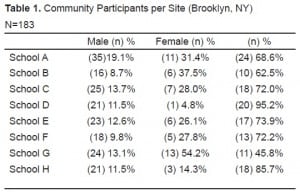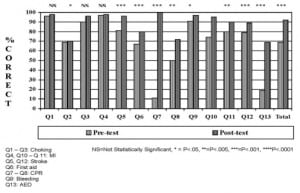| Author | Affiliation |
|---|---|
| Estevan Adan Garcia, MD, MPA | Maimonides Medical Center, Department of Emergency Medicine, Brooklyn, NY |
| Antonios Likourezos, MA, MPH | Maimonides Medical Center, Department of Emergency Medicine, Brooklyn, NY |
| Carl Ramsay, MD | Lenox Hill Medical Center, New York, NY |
| Sherry Hoffman, EMT-P | Maimonides Medical Center, Department of Emergency Medicine, Brooklyn, NY |
| Christopher Niles, MD | Maimonides Medical Center, Department of Emergency Medicine, Brooklyn, NY |
| Michelle Pearl-Davis, DO | Maimonides Medical Center, Department of Emergency Medicine, Brooklyn, NY |
| Seth Podolsky, MD, MS | Maimonides Medical Center, Department of Emergency Medicine, Brooklyn, NY |
| Steven J. Davidson, MD, MBA | Maimonides Medical Center, Department of Emergency Medicine, Brooklyn, NY |
ABSTRACT
Out-of-hospital emergencies occur frequently, and laypersons are often the first to respond to these events. As an outreach to our local communities, we developed “Basic Emergency Interventions Everyone Should Know,” a three-hour program addressing cardiopulmonary resuscitation and automated external defibrillator use, heart attack and stroke recognition and intervention, choking and bleeding interventions and infant and child safety. Each session lasted 45 minutes and was facilitated by volunteers from the emergency department staff. A self-administered 13-item questionnaire was completed by each participant before and after the program. A total of 183 participants completed the training and questionnaires. Average score pre-training was nine while the average score post-training was 12 out of a possible 13 (P< .0001). At the conclusion of the program 97% of participants felt the training was very valuable and 100% would recommend the program to other members of their community.
INTRODUCTION
Out-of-hospital emergencies occur frequently, and laypersons are often the first to respond to these events. High risk events include airway obstruction, cardiopulmonary arrest and cerebrovascular accidents. Community-based educational programs, including first aid and cardiopulmonary resuscitation (CPR) trainings, are available through organizations such as the American Heart Association/American Stroke Association (AHA/ASA).2 The American Academy of Pediatrics’ Committee on School Health recommends basic and pediatric life support (BLS/PBLS) training for all high school students as part of their health education program.1 Additionally, public education campaigns focusing on recognition of choking, stroke and heart attack have been developed to teach laypersons early recognition and basic interventions. Most recently the AHA developed an iPhone application to review first aid procedures and details on responding to first aid situations.3
School- and community-based training programs have been shown to successfully train participants in BLS and potentially impact care of their communities.4–6 As an outreach to our local communities, we developed “Basic Emergency Interventions Everyone Should Know,” a three-hour program addressing basic emergency skills.7 The participants completed pre- and post-training questionnaires to assess the impact of the training program.
METHODS
This study was approved by our local institutional review committee. Informed consent was waived as participation was voluntary. We collected data from June 2007 to May 2008.
Training Scheme
“Basic Emergency Interventions Everyone Should Know” training consisted of a four-part facilitated program addressing CPR and automated external defibrillator (AED) use, heart attack and stroke recognition and intervention, choking and bleeding interventions and infant and child safety. Our emergency department (ED) staff developed the curriculum based on an assessment of needs in our communities. The three-hour format was designed to allow the program to be taught in a single, early evening venue, allowing maximal participation of community members. The sessions were given concurrently, each lasting 45 minutes, and were facilitated by volunteers from the ED staff. Facilitators included emergency medicine and pediatric emergency medical faculty, emergency medicine residents and paramedics. The facilitators modeled skills being taught, and participants performed these skills during each session.
Our community outreach department arranged for the training to take place at eight community settings, including schools and churches. The participants were employees or invited community members from each site. No incentive or compensation was provided. Participants were representative of our local communities.
Each participant completed a self-administered 13-item questionnaire before and after the program. They also completed a pre-test and post-test questionnaire of the training program. The questions included the following topics: recognition and management of choking, understanding of basic CPR, early recognition of stroke and heart attack and AED use. Each correct answer received one point, for a total of 13 points.
Data were analyzed by SPSS version 15.8 We used the Wilcoxon Signed Ranks Test to compare paired pre- and post-test results. Statistical significance was calculated at P< .05.
RESULTS
A total of 183 participants completed the training and questionnaires. The median age of the participants was 47 (14–85). The vast majority was female (72%). Number of participants per community site ranged from 16 to 35 (Table 1).

Average score pre-training was nine with average score post-training of 12 out of a possible 13. The difference between pre- and post-training was significant at P< .0001 (Figure 1). The two questions with the greatest increase in percent correct after training were question 7 (appropriate chest compressions/breath ratio) and question 13 (correct AED operation). For questions 7 and 13 scores increased by almost 90% and 50% respectively. Forty-seven percent of participants rated their level of knowledge and skills in basic emergency interventions as good to proficient prior to training. After training, 86% felt much more prepared or confident in their skills to save lives in an emergency situation (P< .0001). At the conclusion of the program 97% of participants felt the training was very valuable, and 100% would recommend the program to other members of their community.

DISCUSSION
Education programs in basic emergency skills remain a viable option for improving a layperson’s confidence and likelihood of intervening in a life-threatening situation. We found a significant increase in participants’ self-assessment of basic emergency skills after a three-hour facilitated program. The program included a module on AED use, for which most participants had received no previous training. Broad availability of AEDs used by trained volunteers and laypersons has been shown to significantly improve long-term survival of out-of-hospital cardiac arrest victims.9 AEDs are becoming increasingly available in our community settings, and laypersons should feel confident in using these devices when appropriate. “Basic Emergency Interventions Everyone Should Know” is one example of a community-based educational program designed to educate the lay public. This program is easily reproducible by ED staff and can be tailored to address the needs of the local community. Additionally, the modest time commitment allows for the program to be presented in a single session and is appropriate for many audiences.
LIMITATIONS
This program was developed to teach basic emergency skills to members of our community. Our pre-and post-questionnaires were intended to evaluate the effectiveness of our community outreach efforts. We chose to focus on immediate knowledge transfer to our participants. The results showed a significant improvement in scores and mastery of basic emergency skills, including AED operations. It is not known whether skills taught during our training sessions will be retrained, or if this knowledge will change health outcomes of our local communities. Of note, participants were given a copy of the training manual to use as a resource and copies were left within the training sites. Future studies are needed to evaluate long-term retention of basic emergency skills.
CONCLUSION
Our “Basic Emergency Interventions Everyone Should Know” program improved emergency medicine knowledge, skills and confidence of our community members thus increasing their likelihood to assist potential victims of out-of-hospital events. EDs have the opportunity to educate and improve the public’s health and wellbeing through similar outreach programs.
Footnotes
The authors would like to acknowledge the contributions made by Douglas Jablon, vice president, Department of Patient Relations, and his staff, Connie Barone and Karen Cusimano, for their efforts in recruiting and organizing community participants.
Supervising Section Editor: Christopher A. Kahn, MD
Submission history: Submitted January 11, 2010; Revision Received February 24, 2010; Accepted March 15, 2010
Full text available through open access at http://escholarship.org/uc/uciem_westjem
Address for Correspondence: Estevan Adan Garcia, MD, MPA, 965 48th Street, Brooklyn, NY 11219
Conflicts of Interest: By the WestJEM article submission agreement, all authors are required to disclose all affiliations, funding sources, and financial or management relationships that could be perceived as potential sources of bias. The authors disclosed none.
REFERENCES
1. American Academy of Pediatrics Committee on School Health. Basic life support training in schools. Pediatrics. 1993;91:158–159. [PubMed]
2. American Heart Association. Training Programs. Available at www.americanheart.org.
3. American Heart Association. American Heart Association launches first iPhone application: First aid and CPR information within pocket’s reach. Available at www.americanheart.mediaroom.com.
4. Vanderschmidt H, Burnap TK, Thwaites JK. Evaluation of a cardiopulmonary resuscitation course for secondary schools. Med Care. 1975;13:763–74. [PubMed]
5. Plotnikoff R, Moore PJ. Retention of cardiopulmonary resuscitation knowledge and skills by 11 and 12 year old children. Med J Aust. 1989;150:296–302. [PubMed]
6. Vincent R, Martin B, Williams G, et al. A community training scheme in cardiopulmonary resuscitation. Br Med J. 1984;288:617–20. [PMC free article] [PubMed]
7. Maimonides Medical Center. Basic emergency interventions everyone should know. Training manual. 2006
8. SPSS Inc. 233 South Wacker Drive, 11th floor, Chicago, Il: 2006.
9. Cappato R, Curnis A, Marzollo P, et al. Prospective assessment of integrating the existing emergency medical system with automated external defibrillators fully operated by volunteers and laypersons for out-of-hospital cardiac arrest: the Brescia early defibrillation study (BEDS) Eur Heart J. 2006;27:553–61. [PubMed]


